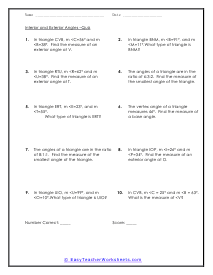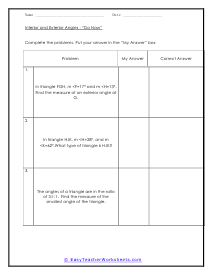Interior angles are all the angles found inside a shape, in this case a triangle (which means we are working with 3 interior angles). The sum of the interior angles is always 180 degrees. With this in mind, if you know two of the measures of the angles in a triangle you can easily determine the third angle just by subtracting their sum from 180 degrees. Exterior angles are angles found outside the triangle. We can normally determining the value of these angles by extending the lines generated by the triangle.
How do you determine the measures of interior and exterior angles of triangles?
Assume the structure that you live in, is polygonal fit as a fiddle. On the off chance that you begin strolling around the structure on any side, as you turn each corner, the point you rotate is the outside edge of that corner. As you arrive at your beginning stage, you are confronting a similar path as when you began, in this way, you have made one complete pivot as you strolled around the structure. That is 360 degrees of revolution. So the entirety of your outside turns is indicated 360 degrees.
Knowing only a couple of things about the inside or outside edges of triangles is now, and then all you have to assemble all the pieces. An outer edge of a triangle is an edge shaped by one side of the triangle and the augmentation of a contiguous side of the triangle. The proportion of an outside edge of a triangle is equivalent to the whole of the proportions of the two non-contiguous inside edges. Each triangle has six outer edges, two at every vertex.
These worksheets explain how find the measure of interior and exterior angles. Students may also have to identify the type of triangle by using information about its angles.








